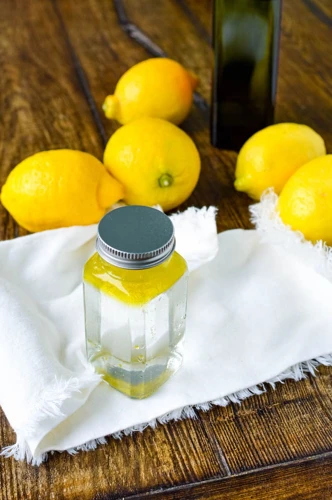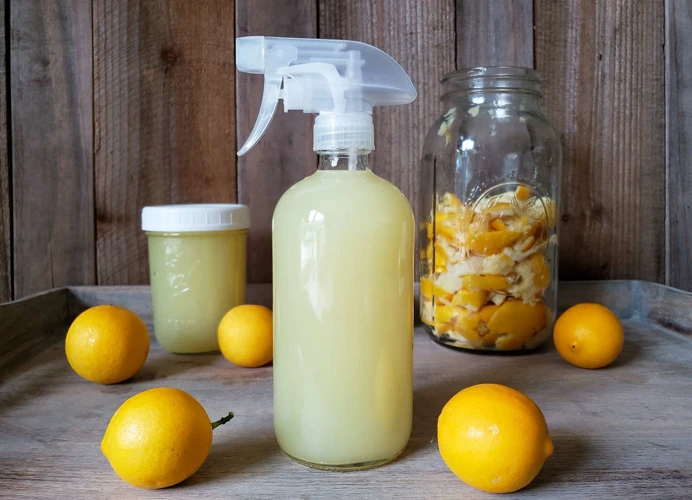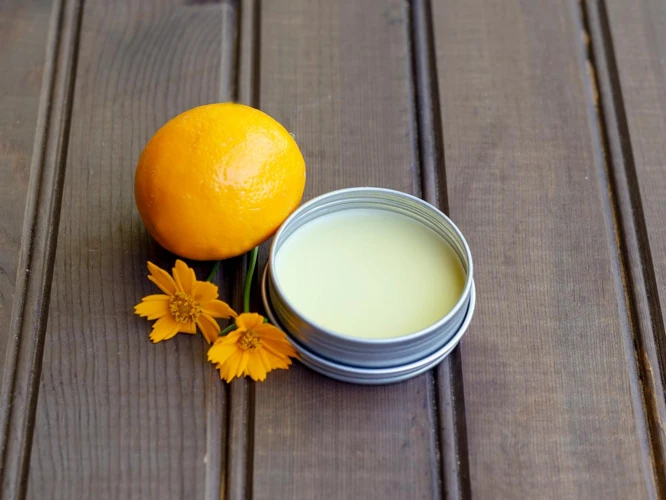There’s nothing quite like a fresh and citrusy scent to make your home feel clean and welcoming. And what better way to achieve this than by using a DIY lemon furniture polish? Not only is it a great way to keep your furniture looking its best, but it’s also all-natural, non-toxic, and easy on the budget. In this article, we’ll guide you through the simple steps to make your own lemon furniture polish and share some tips for using it effectively. So let’s get started and give your home that lemon-fresh fragrance it deserves!
Why Choose a DIY Furniture Polish?

When it comes to cleaning and polishing your furniture, the options available at your local store can be overwhelming. However, have you ever considered making your own DIY furniture polish? Not only is it all-natural and non-toxic, but it’s also affordable and easy to make. In this article, we’ll explore the benefits of choosing a DIY furniture polish compared to store-bought options, and give you step-by-step instructions on how to make your very own fresh and citrusy lemon furniture polish. Plus, we’ll provide some additional tips for keeping your furniture looking its best. So why not skip the store-bought options and give DIY furniture polish a try?
It’s All-Natural and Non-Toxic
Using DIY furniture polish has numerous benefits, and one of the biggest advantages is that it is all-natural and non-toxic. This means that you can use it without any worry of harming your family’s health or the environment. Unlike many store-bought furniture polishes, DIY lemon furniture polish is free from harsh chemicals and synthetic ingredients, making it a safer option for your home.
Some benefits of using all-natural DIY furniture polish are:
- Eliminates the risk of inhaling harmful chemicals, which can cause allergies, headaches, and other health problems.
- Protects wooden furniture without damaging the finish or the environment.
- Uses natural ingredients that are easily accessible and affordable.
- It is customizable, and you can create a unique scent and formula that you enjoy.
- It is an excellent way to reduce pollution and waste, as you can avoid buying disposable or one-use furniture products.
Making your own furniture polish is not only better for your health and the environment, but it can also be a fun and rewarding DIY project.
Using natural ingredients such as vinegar, essential oils, and lemon juice can help you avoid the synthetic chemicals that are often found in commercial furniture polishes. This way, you can ensure that your furniture is safe, clean, and free from harsh chemicals that can leave a sticky residue on the surface.
Using all-natural and non-toxic DIY furniture polish is an ideal choice for those who are looking for an affordable, safe, and eco-friendly way to keep their furniture clean and polished without any negative side effects.
It’s Affordable and Easy to Make
When it comes to keeping your furniture looking its best, there are a lot of options available in the market. However, many of these products can be expensive and may contain harsh chemicals that can be harmful to your health and the environment. This is where making your own furniture polish comes in. Not only is it affordable, but it’s also easy to make and contains all-natural ingredients that are safe for you and your family.
Cost-effective: Making your own furniture polish is an affordable alternative to store-bought products. The ingredients required are simple and budget-friendly, and you can save money in the long run by not having to constantly buy new bottles of furniture polish.
Simple ingredients: All you will need are basic ingredients like vinegar, lemon juice, olive oil, and essential oils, which are easily available in most grocery stores. Not to mention, most of the ingredients required might already be present in your kitchen pantry.
Customizable: With various recipes available online, you can customize your furniture polish with essential oils to create a personalized scent. Additionally, you can also adjust the amount of vinegar or oil depending on how much polishing power you need.
Less harmful: This kind of furniture polish is non-toxic and environmentally friendly, unlike store-bought polishes that contain harsh chemicals.
Making your own DIY Lemon Furniture Polish is both, affordable and easy. You can invest exactly the amount of time you have and make use of the ingredients present at home to prepare a safe product. This way, you can have the satisfaction of maintaining your furniture spotlessly clean, without causing any harm to the environment, and without breaking the bank! If you’re looking for more DIY furniture polish recipes or benefits, check out our other resources on the topic.
Ingredients You Will Need

To create your own lemon furniture polish, you will need a few simple ingredients that you may already have in your pantry. Here is what you’ll need:
Vinegar: 1/4 cup of white vinegar serves as the base for this DIY furniture polish. Vinegar helps to gently clean and remove any dirt or grime from your furniture, while also helping to condition and moisturize it.
Olive Oil: 3/4 cup of olive oil is used to give your furniture a natural shine and protect it from minor scratches. Olive oil is also great for conditioning and nourishing wooden furniture.
Lemon Juice: 1/4 cup of fresh lemon juice adds a fresh and citrusy scent to your furniture polish. Lemon juice is also naturally antiseptic, which helps to kill household bacteria.
Lemon Essential Oil: 10-15 drops of lemon essential oil provides an additional burst of fresh lemon scent to your furniture polish. Essential oils also provide additional cleaning power while leaving behind a pleasant scent that is not overpowering.
These ingredients are all-natural and affordable, making them a great alternative to store-bought furniture polish which often contains harsh chemicals. By making your own furniture polish, you can control the ingredients used and avoid any potential harm to your health or the environment. If you’re interested in learning more about the benefits of using homemade furniture polish, check out this helpful article on ‘Homemade Furniture Polish Benefits‘!
Step-by-Step Instructions

Now that you have gathered all the necessary ingredients, it’s time to learn how to make your own DIY lemon furniture polish. The process is quick and straightforward, requiring only a few simple steps. By making this all-natural and non-toxic furniture polish yourself, you can ensure that your furniture is well taken care of without harming your health or the environment. So, let’s get started with the step-by-step instructions below. And if you’re interested in other homemade furniture polish recipes, check out our article on simple homemade furniture polish for more ideas.
Step 1: Mix the Vinegar and Oil
To begin making your DIY lemon furniture polish, the first step is to mix the vinegar and oil in a bowl. The vinegar serves as a natural cleaning agent while the oil helps to nourish and protect the wood. You can use any type of oil you have on hand, but olive oil is a common choice as it is affordable and easy to find.
Here is a table with the ingredients and measurements you will need:
| Ingredient | Measurement |
|---|---|
| Vinegar | 1/4 cup |
| Olive oil | 1/2 cup |
When mixing the vinegar and oil, use a whisk or fork to combine them thoroughly. Be sure to mix well, as the oil and vinegar will naturally separate over time.
It is important to note that while vinegar is a natural cleaning agent, it should not be used on certain types of wood or furniture finishes. If you are unsure, it is always best to test a small, inconspicuous area before using your DIY furniture polish all over.
For more tips on avoiding common mistakes when making homemade furniture polish, check out our article on common DIY furniture polish mistakes.
Step 2: Add the Lemon Juice and Essential Oil
After mixing the vinegar and oil in a bowl, the next step is to add in the lemon juice and essential oil, which will give the furniture polish its fresh and citrusy scent. Lemon juice is a natural cleaner and deodorizer, making it an excellent addition to any DIY cleaning solution. In addition to its cleaning properties, lemon juice also has a pleasant smell that will leave your furniture smelling fresh and clean.
- Start by squeezing the juice of one lemon into the bowl with the vinegar and oil mixture.
- Next, add several drops of your favorite essential oil. Some great options include lavender, peppermint, or orange oil. Choose an oil that complements the lemon scent and suits your personal preference.
- Use a whisk or fork to mix everything together until the ingredients are well combined.
Adding essential oils to this DIY furniture polish not only enhances the scent, but some oils also have natural cleaning properties as well. For example, peppermint oil is known for its antibacterial properties, while lavender oil has a fresh and calming effect. By adding essential oils to your homemade furniture polish, you can customize the scent and cleaning properties to best suit your needs.
However, it’s important to note that essential oils should be used with caution, as some people may be sensitive to certain scents or have allergic reactions. Always test a small area of your furniture before applying the polish, and consult a healthcare professional before using essential oils if you have any concerns.
Adding lemon juice and essential oils is an easy and effective way to customize your DIY furniture polish and give it a fresh and personalized scent.
Step 3: Transfer to Spray Bottle
Step 3: Transfer the DIY lemon furniture polish to a spray bottle for easy application. It’s important to use a clean and empty spray bottle to avoid any contamination from previous products. You can find spray bottles at your local home goods store or online.
To transfer the mixture to the spray bottle, use a funnel to avoid any spillage. Slowly pour the mixture into the bottle, making sure not to overfill it. Leave some space at the top to prevent leaking and to allow for easy spraying.
Once the mixture is in the bottle, tightly screw on the cap and give it a good shake to make sure all the ingredients are well mixed. Your DIY lemon furniture polish is now ready to use!
Pro Tip: Label the spray bottle with the name and date of the mixture to ensure it’s not confused with any other cleaning products.
If you prefer a more solid furniture polish, you can check out our guide to making beeswax furniture polish. If you’re looking for more DIY furniture polish ideas, check out our article on using coconut oil for furniture polish. Alternatively, you can always purchase furniture polish from your regular store.
How to Use Your DIY Lemon Furniture Polish

Using Your DIY Lemon Furniture Polish: Now that you have made your very own lemon furniture polish, it’s time to put it to good use! When using this polish, it is important to keep in mind that a little goes a long way. You don’t want to oversaturate your furniture with the solution, as this can lead to unwanted streaks and residue.
Step 1: Before applying the polish, remove any visible dust or debris from your furniture with a dry microfiber cloth. This will prevent any scratches or damage to the surface during the polishing process.
Step 2: Once the surface is clean and dry, lightly spray a small amount of the lemon furniture polish onto a clean, soft cloth. You can also spray the polish directly onto the furniture surface, but be sure to start with a small amount and work your way up as needed.
Step 3: Using the cloth, gently rub the polish onto the furniture. Be sure to work in small circular motions and apply even pressure. This will help to evenly distribute the polish and ensure a smooth, streak-free finish.
Step 4: Once you have covered the entire surface with the polish, use a separate clean cloth to buff away any excess solution. This will help to bring out the shine and luster of your furniture.
Step 5: Repeat this process as needed, depending on the level of shine and cleanliness you desire. For best results, use your DIY lemon furniture polish once a month or as needed.
Remember, this lemon furniture polish is all-natural and non-toxic, making it safe to use on a variety of surfaces in your home. It will leave your furniture smelling fresh and clean, while also providing a protective barrier against future dust and dirt buildup.
If you’re short on time or just prefer a store-bought option, consider checking out our furniture polish selection in our store. Whatever option you choose, be sure to regularly care for and maintain your furniture for long-lasting beauty and functionality.
Other Tips for Cleaning and Polishing Furniture
Maintaining the cleanliness and polish of furniture doesn’t end with DIY lemon furniture polish. Here are some additional tips to keep your furniture in top condition:
1. Avoid abrasive cleaners – When cleaning furniture, it’s best to avoid using abrasive cleaners such as bleach or ammonia. These can damage the finish and cause discoloration.
2. Clean spills immediately – Accidents happen, but leaving spills on furniture for too long can cause stains and damage. Make sure to wipe up spills immediately using a soft cloth.
3. Use soft cloths – Speaking of cloths, make sure to use soft ones when cleaning furniture. Rough or scratchy cloths can leave marks on the surface.
4. Test on a small area – Before using any cleaning product or polish on your furniture, make sure to test it on a small area first. This way, you can see if there are any adverse effects or damage to the finish.
5. Dust regularly – Dust may seem harmless, but it can build up over time and cause scratches on the surface. Make sure to dust your furniture regularly using a soft cloth.
6. Polish once a month – To maintain the shine and smoothness of the furniture, it’s recommended to polish it once a month. This will also help protect the surface from damage.
By following these tips, you can keep your furniture looking great for years to come. And with DIY lemon furniture polish, you can achieve a fresh and citrusy scent while keeping your furniture clean and polished.
Conclusion
In conclusion, creating your own DIY lemon furniture polish is a simple and effective way to keep your wooden furniture looking its best. Not only is it all-natural and non-toxic, but it is also affordable and easy to make using ingredients that you may already have in your kitchen. By combining the cleaning power of vinegar and the moisturizing effects of oil with the refreshing scent of lemon and essential oils, you can create a furniture polish that not only cleans and shines but also leaves behind a pleasant and uplifting aroma.
Using this DIY lemon furniture polish, you can confidently tackle dust, grime, and tough stains on your wooden furniture, restoring their natural beauty and shine. Remember to shake the bottle well before each use and always test the polish on a small, inconspicuous area of your furniture before applying it all over. Additionally, it is always a good idea to dust your furniture regularly and avoid using abrasive cleaning tools or harsh chemicals that may damage the wood.
Overall, by taking care of your wooden furniture with homemade cleaning solutions like this DIY lemon furniture polish, you can not only extend their lifespan but also reduce your exposure to harmful chemicals found in many commercial furniture polishes. So, grab your ingredients and try making your own lemon furniture polish today!
Frequently Asked Questions
What type of vinegar should I use for this DIY furniture polish?
You can use any type of vinegar, but white vinegar or apple cider vinegar are good options.
Can I substitute olive oil with another type of oil?
Yes, you can use any type of vegetable oil or even coconut oil.
Can I skip the essential oil if I don’t have any?
Yes, the essential oil is optional and is just added for fragrance. You can skip it if you wish.
Are there any surfaces I shouldn’t use this polish on?
Avoid using this polish on unfinished or unsealed wood as it may damage the surface.
How long does this furniture polish last?
The polish can last for several months if stored properly in a cool, dry place.
Will the lemon in the polish attract bugs?
No, the small amount of lemon juice in the polish should not attract bugs.
Can I use this polish on painted furniture?
Yes, you can use this polish on painted furniture, but test it on a small, inconspicuous area first to ensure it won’t damage the paint.
Should I shake the spray bottle before each use?
Yes, be sure to give the spray bottle a good shake before each use to ensure the ingredients are mixed together.
Can I use this polish on leather furniture?
No, this polish is not suitable for leather furniture. Use a cleaner specifically designed for leather instead.
Is this polish safe for pets and children?
Yes, this all-natural polish is safe for pets and children as it does not contain any harsh chemicals.
